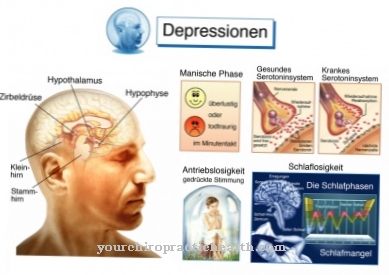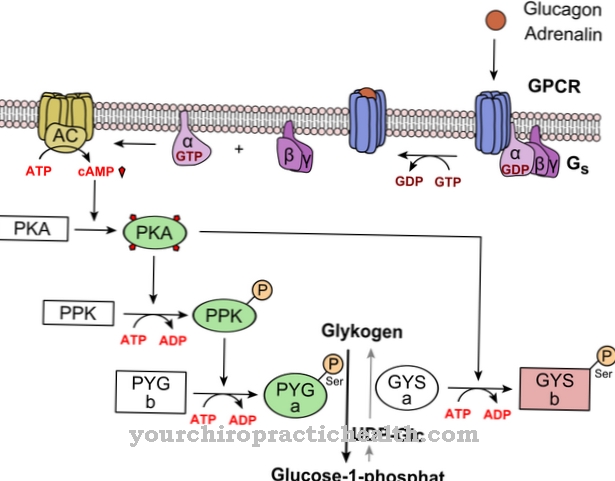The Diving disease or decompression sickness has been the undoing of many divers in the past because their causes were not sufficiently researched and known. With the knowledge available today and state-of-the-art technology, diving disease can be defeated and prevented.
What is diving disease?

© dovla982 - stock.adobe.com
The slang term Diving disease is used for a health impairment under the term decompression sickness is much more meaningful.
Diving sickness or decompression sickness is not unique to divers. It can also be fatal when exiting into a vacuum, such as in space. Other names for diving disease are compressed air or caisson disease.
The causal factors that lead to diving disease have only been known since the middle of the 20th century. The name caisson disease goes back to so-called caissons, with which the caisson workers were let into the depths of water and pulled up again. In medicine, diving disease is considered a trauma.
causes
The causes of Diving disease are due to the fact that after a stay at a certain depth, surfacing leads to an anesthetic-like trauma in the neurological area.
When people dive and reach enormous depths, the nitrogen in the compressed air is pressed into individual tissues of the body. If the water pressure drops during the ascent, the gases suddenly rise into the brain because they cannot be exhaled through the lungs, so that diving disease develops.
This process takes place in diver's disease when there is a hasty ascent.
Symptoms, ailments & signs
Diver's disease is divided into two classes depending on the severity of the symptoms. Type I only causes slight discomfort, typical pain in the joints and muscles. Closure of small blood vessels (microembolism) causes the skin on the face, ears, upper body and arms to itch, and patches of skin that resemble insect bites (diving fleas) develop.
The formation of edema is possible. Air can collect in the subcutaneous tissue, which is clearly visible through deformations. These accumulations of air crackle or crunch when you feel it. Type II of the disease shows, in addition to the symptoms of type I, other strong symptoms that can be life-threatening. The central nervous system is affected and neurological failures occur. Paralysis and sensory disorders are possible.
The oxygen supply to the brain and heart can be interrupted by nitrogen bubbles in the vessels or in the organ itself. A clouding of consciousness can occur which can lead to unconsciousness and respiratory failure. Other complaints are severe headaches, chest pain, cardiovascular disorders and dizziness.
Shortness of breath occurs and the patient feels as if he is suffocating. Coordination disorders arise and the ability to speak is impaired. In severe cases, tissue and bone necrosis can occur. If left untreated, the disease can lead to death.
Diagnosis & course
If the divers ascend too quickly from a great depth and after a long dive, the microbubbles in the tissue not only lead to a state of intoxication, but can also cause the Diving disease also destroy individual tissue regions in which they were stored.
With diving disease, people can lose their bearings and even lose consciousness, which used to be a common cause of drowning. Symptoms typical for a course of diving illness include pain in the joints and muscles, edema, persistent itching, fatigue and weakness, disorders of skin perception and coordination, nausea, vomiting, loss of hearing and vision and, after unconsciousness, breathing stops.
There are mild and severe, fatal forms of diving disease. When diagnosing diver's disease, the focus is particularly on the condition of those affected.
Complications
Depending on the type of diver's disease, different complications and long-term effects can occur. Type 1 diving disease causes pain in the muscles of the arms, legs and joints. Under certain circumstances, these are associated with restricted mobility and poor posture, which can result in joint damage and, as a consequence, premature joint wear.
Type 2 diving disease almost always causes serious complications that can also be life threatening. When nitrogen bubbles clog blood vessels, the central nervous system, heart, and lungs are seriously damaged. The supply to the brain can also be blocked, which quickly causes irreversible damage.
The typical sequelae include speech disorders, paralysis, damage to the inner ear, pain and loss of consciousness. As a complication of diving disease, gas embolism can occur in the lungs, which leads to lung tissue death and ultimately organ failure. Symptoms of a stroke can also occur.
Incorrectly performed first aid measures can cause serious complications. Medical treatment is always associated with the risk that the medication administered may cause side effects, interactions or an allergic reaction.
When should you go to the doctor?
If divers have pain in their muscles, bones, or joints, they need a medical examination. Itching in the area of the upper body, changes in the normal skin texture and swelling are signs of a health problem. A doctor's visit is necessary as complications can arise in severe cases. Sensitivity disorders, air accumulation in the organism and loss of memory are alarm signals of the organism.
Crackling noises are characteristic of diver's disease as soon as light pressure is exerted on the body's swellings from outside. If a noise is heard, a doctor should be consulted as soon as possible. If you lose consciousness or your breathing has stopped, an emergency service must be alerted. Intensive medical treatment is required because the person concerned is threatened with death. Before the emergency doctor arrives, first aid measures must be carried out by those present.
If headaches, dizziness, impaired breathing or changes in speech abilities occur immediately after a dive or while surfacing, a medical examination is required. An internal weakness, general malaise and loss of physical performance should be presented to a doctor. Chest discomfort and coordination disorders are further signs of an irregularity. If the symptoms are found in people who have come from a vacuum, a doctor's visit is also necessary.
Treatment & Therapy
So that the Diving disease If the symptoms are alleviated and the risks of a fatal course and extensive long-term effects are reduced, immediate treatment is required.
If the condition of the person concerned is acutely life-threatening with a diving illness (loss of consciousness, respiratory failure), emergency care must be provided (artificial respiration, stable lateral position).
As a further therapeutic measure, a different length of stay in a so-called pressure chamber is initiated. The purpose of this is that the gas bubbles embedded in the tissue can slowly escape again through the pressure adjustment. Overpressure acts on the patient in the pressure chamber. During this period, they remain in direct contact with the doctor via radio in order to be able to carry out targeted observation and to rule out further hazards.
Due to the overpressure chamber, the organism gradually adapts to the pressure conditions prevailing on the earth's surface. The untreated diver's disease should not be underestimated in connection with the possible long-term consequences. These particularly affect the bone and lung tissue.
prevention
To one Diving disease To prevent this, it is important to have fully functional control and display instruments with you during the dive. The risk factors for diving disease increase the longer and deeper you dive. The entire diving undertaking should also be adapted to the given physical conditions in order to prevent decompression sickness.
The divers should not overestimate themselves in order to keep the risks as low as possible. When surfacing you should not be left alone and you should absolutely observe the appropriate decompression times so that diving illness can be avoided.
Aftercare
A successful, completed treatment of diving disease requires a complete elimination of the gas bubbles in the body. Depending on the severity of the disease, permanent damage cannot be ruled out. Once the treatment of a mild to mild illness has been completed, no further follow-up examinations are necessary. The affected person is free of symptoms and signs.
In the event of a serious illness with permanent damage or disabilities, appropriate follow-up treatment must be initiated. Particular caution is required if the person concerned wants to dive again. In this case, a specially trained diving doctor should be consulted. This decides whether and when diving is possible again. Depending on the severity of the illness, this varies between a few days and several months.
Since the person concerned is pre-stressed, a relapse or further illness cannot be ruled out when diving again. It is not uncommon for this to be more serious than the first illness. In the future, diving must be more conservative than before, which includes strict adherence to the generally known diving rules.
No decompression dives or extremely deep dives, as the risk of getting sick again is significantly higher. Instead of using a normal air mixture, dive with an oxygen-enriched mixture (Nitrox) and a dive computer in air mode. Avoidance of repetitive dives with short surface breaks. Avoid physical exertion before, after and during the dive.
You can do that yourself
Before every dive, you should check whether your general health is optimal for the project. In the event of the slightest inconvenience or health impairment, the diving process should be canceled or postponed. Existing fears, internal insecurities or a weakening of the organism can lead to considerable consequences while diving. Therefore, in the area of self-help, early and critical control of one's own well-being is necessary.
Overestimating one's own skills can lead to life-threatening developments. A diving venture should never be done alone. A partner is required so that help can be provided immediately in the event of irregularities. The emergency signals must be jointly determined in advance. In addition to checking the equipment, a good agreement is one of the necessary measures before diving. Health issues should also be addressed. Past experiences are to be communicated to the partner. Every diver must know and observe his own physical limits.
As soon as problems or health disorders occur during the diving process, the diving partner must be informed accordingly and the diving process must be ended as quickly as possible without hectic. Often it is sufficient if the depth reached is checked in good time so that there are no impairments. The ascent must not be too fast. Care should be taken to prevent irreversible damage from developing.






.jpg)

















.jpg)



